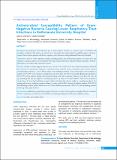Please use this identifier to cite or link to this item:
https://hdl.handle.net/20.500.14356/1475Full metadata record
| DC Field | Value | Language |
|---|---|---|
| dc.contributor.author | Sherchan, Jatan Bahadur | - |
| dc.contributor.author | Humagain, Sanjay | - |
| dc.date.accessioned | 2023-05-14T07:45:09Z | - |
| dc.date.available | 2023-05-14T07:45:09Z | - |
| dc.date.issued | 2020 | - |
| dc.identifier.citation | SherchanJ. B., & HumagainS. (2021). Antimicrobial Susceptibility Pattern of Gram-Negative Bacteria Causing Lower Respiratory Tract Infections in Kathmandu University Hospital. Journal of Nepal Health Research Council, 18(4), 661-666. https://doi.org/10.33314/jnhrc.v18i4.2566 | en_US |
| dc.identifier.issn | Print ISSN: 1727-5482; Online ISSN: 1999-6217 | - |
| dc.identifier.uri | http://103.69.126.140:8080/handle/20.500.14356/1475 | - |
| dc.description | Original Article | en_US |
| dc.description.abstract | Abstract Background: Respiratory tract infection due to Gram-negative bacteria is a common cause of morbidity and mortality worldwide. This study was carried out to determine the antimicrobial susceptibility pattern of Gram-negative bacteria from patients with lower respiratory tract infection visiting Kathmandu University Hospital. Methods: A total of 3,403 respiratory samples including sputum and endotracheal aspirates were processed and antibiotic resistance pattern was determined following Clinical Laboratory Standard Institute guidelines. Patients’ information was obtained after informed consent. Results: Growth of Gram-negative bacteria was 210 (6.17%). 83(39.52%) were Klebsiella pneumoniae followed by Escherichia coli, Pseudomonas aeruginosa, Acinetobacter species, Klebsiella oxytoca, Enterobacter species, Proteus mirabilis and Haemophilus influenzae. 151(71.90%) isolates were multidrug resistant. None of the strains were resistant to colistin. 51(24.29%) were resistant to carbapenem and out of these 3(1.43%) were metallo-? lactamase producers. 89(65.92%) of the patients having both pneumonia along with other respiratory illnesses were above 60 years of age indicating that old age might be a predisposing factor. (p value is less than 0.0001). 92(81.42%) of patients of age above 60 years had multidrug resistant isolates indicating that old age might be a predisposing factor for getting infection my multidrug resistant isolates. (p value equals 0.0012) Among 36 diabetic patients 33(91.67%) had multidrug resistant isolates. Whereas out of 174 non-diabetic patients only 118(67.82%) had multidrug resistant isolates (p value equals 0.0037). Conclusions: Multidrug-resistant Gram negative bacteria were observed in respiratory samples. Effective treatment of lower respiratory tract infection need detailed microbiological diagnosis and drug susceptibility testing. Keywords: ESBL; LRTI; MBL; MDR | en_US |
| dc.language.iso | en | en_US |
| dc.publisher | Nepal Health Research Council | en_US |
| dc.relation.ispartofseries | Oct-Dec, 2020;2566 | - |
| dc.subject | ESBL | en_US |
| dc.subject | LRTI | en_US |
| dc.subject | MBL | en_US |
| dc.subject | MDR | en_US |
| dc.title | Antimicrobial Susceptibility Pattern of Gram-Negative Bacteria Causing Lower Respiratory Tract Infections in Kathmandu University Hospital | en_US |
| dc.type | Journal Article | en_US |
| local.journal.category | Original Article | - |
| Appears in Collections: | Vol. 18 No. 4 (2020): Vol. 18 No. 4 Issue 49 Oct-Dec 2020 | |
Files in This Item:
| File | Description | Size | Format | |
|---|---|---|---|---|
| 2566-Manuscript-19996-1-10-20210122.pdf | Fulltext Download | 290.75 kB | Adobe PDF |  View/Open |
Items in DSpace are protected by copyright, with all rights reserved, unless otherwise indicated.
